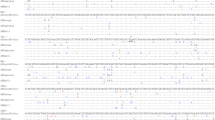Abstract
Hepatitis B virus (HBV) is an important human pathogen belonging to the Hepadnaviridae family, Orthohepadnavirus genus. Over 240 million people are infected with HBV worldwide. The reverse transcription during its genome replication leads to low fidelity DNA synthesis, which is the source of variability in the viral proteins. To investigate the variability quantitatively, we retrieved amino acid sequences of 5,167 records of all available HBV genotypes (A–J) from the Genbank database. The amino acid sequences encoded by the open reading frames (ORF) S/C/P/X in the HBV genome were extracted and subjected to alignment. We analyzed the variability of the lengths and the sequences of proteins as well as the frequencies of amino acids. It comprehensively characterized the variability and conservation of HBV proteins at the level of amino acids. Especially for the structural proteins, hepatitis B surface antigens (HBsAg), there are potential sites critical for virus assembly and immune recognition. Interestingly, the preS1 domains in HBsAg were variable at some positions of amino acid residues, which provides a potential mechanism of immune-escape for HBV, while the preS2 and S domains were conserved in the lengths of protein sequences. In the S domain, the cysteine residues and the secondary structures of the alpha-helix and beta-sheet were likely critical for the stable folding of all HBsAg components. Also, the preC domain and C-terminal domain of the core protein are highly conserved. However, the polymerases (HBpol) and the HBx were highly variable at the amino acid level. Our research provides a basis for understanding the conserved and important domains of HBV viral proteins, which could be potential targets for anti-virus therapy.




Similar content being viewed by others
References
Bruss V (2004) Envelopment of the hepatitis B virus nucleocapsid. Virus Res 106:199–209
Buynak EB, Roehm RR, Tytell AA, Bertland AU, Lampson GP, Hilleman MR (1976) Vaccine against human hepatitis B. JAMA 235:2832–2834
Chouteau P, Le Seyec J, Cannie I, Nassal M, Guguen-Guillouzo C, Gripon P (2001) A short N-proximal region in the large envelope protein harbors a determinant that contributes to the species specificity of human hepatitis B virus. J Virol 75:11565–11572
Dembek C, Protzer U, Roggendorf M (2018) Overcoming immune tolerance in chronic hepatitis B by therapeutic vaccination. Curr Opin Virol 30:58–67
Heermann KH, Goldmann U, Schwartz W, Seyffarth T, Baumgarten H, Gerlich WH (1984) Large surface proteins of hepatitis B virus containing the pre-s sequence. J Virol 52:396–402
Jones DT (1999) Protein secondary structure prediction based on position-specific scoring matrices. J Mol Biol 292:195–202
Le Duff Y, Blanchet M, Sureau C (2009) The pre-S1 and antigenic loop infectivity determinants of the hepatitis B virus envelope proteins are functionally independent. J Virol 83:12443–12451
Seeger C, Mason WS (2000) Hepatitis B virus biology. Microbiol Mol Biol Rev 64:51–68
Seeger C, Mason WS (2015) Molecular biology of hepatitis B virus infection. Virology 479:672–686
Short JM, Chen S, Roseman AM, Butler PJG, Crowther RA (2009) Structure of hepatitis B surface antigen from subviral tubes determined by electron cryomicroscopy. J Mol Biol 390:135–141
Sievers F, Wilm A, Dineen D, Gibson TJ, Karplus K, Li W, Lopez R, McWilliam H, Remmert M, Söding J (2011) Fast, scalable generation of high-quality protein multiple sequence alignments using Clustal Omega. Mole Syst Biol 7:539
Yan H, Zhong G, Xu G, He W, Jing Z, Gao Z, Huang Y, Qi Y, Peng B, Wang H (2012) Sodium taurocholate cotransporting polypeptide is a functional receptor for human hepatitis B and D virus. eLife 1:e00049
Yu X, Jin L, Jih J, Shih C, Zhou ZH (2013) 3.5 Å cryoEM structure of hepatitis B virus core assembled from full-length core protein. PLoS ONE 8:e69729
Zlotnick A, Cheng N, Stahl SJ, Conway JF, Steven AC, Wingfield PT (1997) Localization of the C terminus of the assembly domain of hepatitis B virus capsid protein: implications for morphogenesis and organization of encapsidated RNA. Proc Natl Acad Sci 94:9556–9561
Acknowledgements
The authors would like to thank Prof. Ping Zhu (Institute of biophysics, Chinese Academy of Sciences) and Prof. Jingqiang Zhang (Sun Yat-sen university), who provided help in this research. This work was partially supported by the National Natural Science Foundation of China (Nos. U1611265, 81773271 and 31672536) and the Key Projects of Department of Education of Guangdong Province (No. 2017KZDXM088). The funders had no role in study design, data collection and analysis, decision to publish or preparation of the manuscript.
Author information
Authors and Affiliations
Contributions
Author Contributions
JC, SL and YX designed the study. JC conducted computational work, JC and YX performed data analysis. JC, SL and YX wrote the manuscript draft.
Corresponding authors
Ethics declarations
Conflict of interest
The authors declare that they have no conflict of interest.
Animal and Human Rights Statement
This article does not contain any studies with human or animal subjects performed by any of the authors.
Electronic supplementary material
Below is the link to the electronic supplementary material.
Rights and permissions
About this article
Cite this article
Cao, J., Luo, S. & Xiong, Y. The Variability of Amino Acid Sequences in Hepatitis B Virus. Virol. Sin. 34, 42–49 (2019). https://doi.org/10.1007/s12250-018-0070-x
Received:
Accepted:
Published:
Issue Date:
DOI: https://doi.org/10.1007/s12250-018-0070-x




